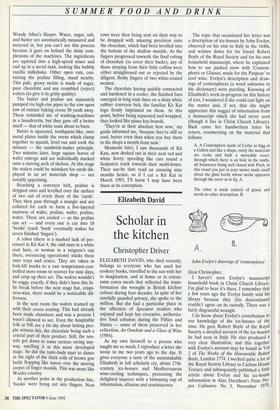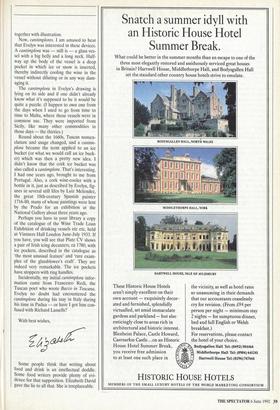Elizabeth David
Scholar in the kitchen
Christopher Driver
ELIZABETH DAVID, who died recently, belongs to everyone who has used her cookery books, travelled to the sun with her in imagination, and at home or in restau- rants eaten meals that reflected the trans- formation she wrought in British kitchen culture during four decades. In spite of her carefully guarded privacy, she spoke to the million. But she had a particular place in the affection of Spectator readers who enjoyed and kept her evocative, authorita- tive food columns during the Fifties and Sixties — some of them preserved in her collection, An Omelette and a Glass of Wine (1984).
As my own farewell to a person who taught me so much, I reproduce a letter she wrote to me two years ago to the day. It gives everyone a taste of the unmistakable Elizabeth in full scholarly cry, about 17th- century ice-houses and Mediterranean wine-cooling techniques, presenting the delighted inquirer with a brimming cup of information, allusion and reminiscence.
The topic that occasioned her letter was a description of ice-houses by John Evelyn. observed on his visit to Italy in the 1640s, and written down for his friend Robert Boyle of the Royal Society and for his own household manuscript, where he explained how to use packed snow with 'Contem- plores or Glasses, made for the Purpose' to cool wine. Evelyn's description and draw- ings of contemplores (a word unknown to the dictionary) were puzzling. Knowing of Elizabeth's work-in-progress on this history of ices, I wondered if she could cast light on the matter and, if not, that she might appreciate this nugget of information from a manuscript which she had never seen (though it lies in Christ Church Library). Back came her handwritten letter by return, commenting on the material that follows: A. A Contemplore made of Corke as bigg as a Gallon and like a shape, onely the materials are corke and hath a moveable cover, through which there is an hole in the midle, all Joinctures being well closed with Pitch, in this vessel you put in your snowe made small about the glass bottle whose necke appeares through the cover as in fig. A.
The other is made entirely of glasse and needs no other description. B.
John Evelyn's drawings of 'contemplores' Dear Christopher, I haven't seen Evelyn's manuscript household book in Christ Church Library. I'm glad to hear it's there. I remember that a few years ago the Evelyn family sold his library because they (his descendants) couldn't agree on its custody. There was a fairly disgraceful wrangle.
I do know about Evelyn's contribution to our knowledge of the ice-houses of the time. He gave Robert Boyle of the Royal Society a detailed account of the ice-houses he had seen in Italy. He also produced a very clear illustration, and this together with Evelyn's account may be found in Vol 2 of The Works of the Honourable Robert Boyle, London 1774. 1 worked quite a lot at the Royal Society Library in Carlton House Terrace and subsequently published a little article about Evelyn and his ice-house information in Alan Davidson's Petits Pro- pos Culinaires No 3, November 1979,
together with illustration.
Now, cantimplores. I am amused to hear that Evelyn was interested in these devices.
A cantimplora was — still is — a glass ves- sel with a big belly and a long neck. Half-
way up the body of the vessel is a deep pocket in which ice or snow is inserted, thereby indirectly cooling the wine in the vessel without diluting or in any way dam- aging it.
The cantimplora in Evelyn's drawing is lying on its side and if one didn't already
know what it's supposed to be it would be quite a puzzle. (I happen to own one from the days when I used to go from time to time to Malta, where these vessels were in common use. They were imported from Sicily, like many other commodities in those days — the thirties.)
Round about the 1660s, Tuscan nomen- clature and usage changed, and a cantim- plora became the term applied to an ice bucket (or what we would call an ice buck- et) which was then a pretty new idea. I
didn't know that the cork ice bucket was
also called a cantimplora. That's interesting. I had one years ago, brought to me from
Portugal. Also, a cork wine-cooler with a bottle in it, just as described by Evelyn, fig- ures in several still lifes by Luiz Melendez,
the great 18th-century Spanish painter 1716-80, many of whose paintings were lent by the Prado for an exhibition at the National Gallery about three years ago.
Perhaps you have in your library a copy of the catalogue of the Wine Trade Loan Exhibition of drinking vessels etc etc, held at Vintners Hall London June-July 1933. If you have, you will see that Plate CV shows a pair of Irish icing decanters, ca 1780, with ice pockets, described in the catalogue as the most unusual feature' and 'rare exam- ples of the glassblower's craft'. They are indeed very remarkable. The ice pockets have stoppers with ring handles.
Incidentally, my initial cantimplora infor- mation came from Francesco Redi, the Tuscan poet who wrote Bacco in Toscana. Evelyn no doubt had encountered the cantimplora during his stay in Italy during his time in Padua — or have I got him con- fused with Richard Lassells?
With best wishes, Some people think that writing about food and drink is an intellectual doddle. Some food writers provide plenty of evi- dence for that supposition. Elizabeth David gave the lie to all that. She is irreplaceable.



































































 Previous page
Previous page